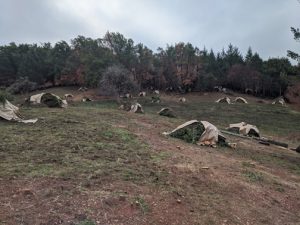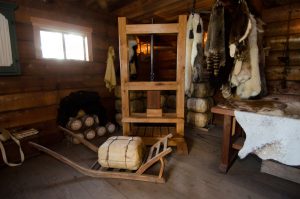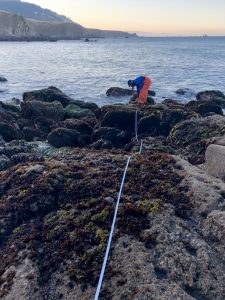FEBRUARY 2021 ENEWS
Meyers Fire Recovery
Dear friends of Salt Point and Fort Ross,
While today the coast looks lush and alive wrapped in its bright seasonally-verdant carpet, I wanted to look back six short months ago to provide an update on the Meyers Fire.
 In August of 2020, lightning strikes started fires across the Bay Area and beyond. The Meyers Fire, part of the LNU Lightning Complex Fire, burned 2,000 acres, 500 of which were at Fort Ross State Historic Park. The fire ran southeast of Reef Campground from Highway 1 to Meyers Grade. While it came less than a mile away from the fort compound, the historic cemetery, and the Fort Ross Visitor Center, coastal conditions were fairly forgiving -- especially important given that emergency resources were spread very thin, contending with hundreds of fires across the county and state.
In August of 2020, lightning strikes started fires across the Bay Area and beyond. The Meyers Fire, part of the LNU Lightning Complex Fire, burned 2,000 acres, 500 of which were at Fort Ross State Historic Park. The fire ran southeast of Reef Campground from Highway 1 to Meyers Grade. While it came less than a mile away from the fort compound, the historic cemetery, and the Fort Ross Visitor Center, coastal conditions were fairly forgiving -- especially important given that emergency resources were spread very thin, contending with hundreds of fires across the county and state.
We are fortunate to receive support from the exceptionally dedicated Fort Ross and Timber Cove volunteer fire houses and our community worked very hard to keep the Meyers Fire from bearing down on Fort Ross. Remember to thank a firefighter, the more so when fire season feels very far away!
Not surprisingly, this fire affected many Fort Ross Conservancy staffers who live in the coastal hills and it was a very difficult few days. Knowing that this will likely happen again, a Community Response Meeting will convene in March to bring together citizen, local and state firefighters to work towards a common goal of fire pre-planning, fire organization and prevention.
Six months later the fire scars are still very visible but fresh foliage is carpeting the burned area. Today, California State Parks Environmental Scientist Chris Heintzelman is working with crews from the California Conservation Corp to repair the landscape, in particular filling in bulldozer lines made to create fire breaks, repairing fences, and removing dead trees along the roadways. The longer term goal is to remove Douglas firs that are within 100 feet from the roadways along Meyer’s Grade, Seaview, and Fort Ross Road, both to help with fuel reduction but also to reduce competition and allow for a more diverse mix in the hardwoods forest:
“State Parks working with the Ukiah office of The California Conservation Corps (CCC) has begun a fuel reduction project within Fort Ross SHP along Meyers Grade and Seaview Road. This project will create a shaded fuel break within 100 feet of the roads edge by removing small diameter Doug-firs, ladder fuels and dead or dying trees. The biomass will be piled and covered with kraft paper to minimize impacts to air quality and to allow for safe pile burning operations. The goals of this project are to minimize potential impacts of future wildfires, enhance ingress and egress during an emergency and to enhance the mixed hardwood forest found on the ridge tops of Fort Ross SHP. Please contact the project manager, Chris Heintzelman (Chris.Heintzelman@parks.ca.gov) with any questions.”
There is significant work to be done to address the health of these forests which have not experienced frequent but less intense fires for many decades, and which are now adapting to warmer weather and shorter, weaker rainfall. For the moment we can enjoy the seasonal promise of a green landscape and hope for more rain and a milder fire season ahead.
Sincerely,
Sarah
Sarah Sweedler
Fort Ross Conservancy CEO
Fort Ross Tannery - Important Industry of Early California

Fort Ross was a major leather goods manufacturing center of early Colonial California with a well-established tanning industry that emerged from the need to process the sea otters catch. Before any money could be made from international fur trade, where extremely soft and warm sea otter pelts were the most sought after commodity, the catch had to be processed through a procedure called tanning which changed raw hide into a leather product. A tanner was a respected and valued profession at Fort Ross.
A tannery was one of the first industries assembled on Sandy Beach at the mouth of Fort Ross Creek after the arrival of the Russians to the ancient Kashia village of Metini. French explorer Eugene Duflot de Mofras, who visited California in 1840, left this description of the "shop equipped with various machines for tanning, dressing, and preparing hides, 10 meters long and 6 deep." According to Major Ernest Rufus who administered the Fort in the 1840s after Russians had left, the tannery had “six vats in all, constructed of heavy, rough redwood slabs, and each with a capacity of fifty barrels. They had all the usual appliances necessary to conduct a tannery, such as scrapers, mullers, etc., but these implements were large and rough in their make.
"Because the sea otter catch quickly declined after the founding of the colony, the tanners soon switched their attention to processing other products including cow hides, deer hides, and sea lion skins to make leather products for international and domestic use. A wonderful article “The Beginnings of Tanning in California” by Patricia M. Bauer traces back the Russian tanning legacy in California which was adopted by California pioneers.
After slaughtering the animals, the hides were cured using salt to prevent putrefaction. Then they were washed in water to remove all the extraneous matter such as salt, blood, dirt and dung. The next step of production involved placing the skins in vats containing a variety of solutions.
 First, the hides were transferred to a vet with a lime and water solution to soften the hides to allow for the removal of excess hair, fat and any residue left on the skins. It is believed that lime was obtained from sea shells after they were burned in a kiln. The hides then entered a tedious soaking and resting period in the vats of weaker lime infused solution which took up to six months to complete.
First, the hides were transferred to a vet with a lime and water solution to soften the hides to allow for the removal of excess hair, fat and any residue left on the skins. It is believed that lime was obtained from sea shells after they were burned in a kiln. The hides then entered a tedious soaking and resting period in the vats of weaker lime infused solution which took up to six months to complete.
The next phase of the leather production journey involved preserving and coloring the hides. An important step of the production process involved the use of a “stamping machine” to ground the bark from local oak trees to extract tannin, Bauer notes, explaining that this machine was powered by the windmill. According to Rufus, the machine "was made of solid iron, and was about four inches square. It was hung upon a crank, upon the main shaft of the wind wheel, and the motion was thus given to it. It was a simple and very effective device, but required the constant attention of an operator to turn the bark and stir it up."
According to Bauer, the tanning process consisted of “(1) coloring, by suspension in vats of weak or old ‘liquor;’ (2) the ‘handling’ of the hides by placing them in a series of vats of tan liquor… (3 ) the ‘dusting’ of the hides with a small quantity of solid tanning material, after which they are placed in vats of freshly leached tannin. Here they remain for several weeks, allowing "bloom" - a yellowish powdery coating - to be deposited, the reaction which causes the bloom ensuring a firm, hard leather.” Upon completion of these steps, the hides were drained and scoured to remove the “bloom” from the grain, before being left to dry slowly in the wind. During the drying process a coating of oil was constantly applied to the skins to keep the grain surface from drying out. The skins were now ready to be sold or used by the Russian American Company to make leather goods such as boots, saddles, and hats.
When Sutter bought the Russian property in 1841 he also purchased the Fort Ross tannery, which was put to use by Major Rufus. “Sutter, his business partner, Major Rufus...decided to manufacture leather, taking advantage of the Russian equipment and using a recipe for tanning that was in an ‘encyclopaedia of scientific information’ which he had brought with him,” Bauer claims in her article, noting that the pioneer had very little initial success, until he visited another tannery, most likely in Santa Cruz, to observe the process. Upon his return, Rufus resurrected the tanning industry at Fort Ross, supplying plenty of hides to the local market.
“After his visit to the tannery, Rufus tried making leather again at the fort and this time with success. The nearest market for leather, according to his account, was Monterey, so he ‘hied himself’ thither, ‘with his roll of leather on a pack pony,’ sold his product readily, and continued operating at Fort Ross for some years,” Bauer observed.
It appears that Rufus was able to control the local market all the way until 1851, when Capt. Stephen Smith built a tannery in Bodega, a year after California became part of the US. But that is an entirely different story!
- Igor Polishchuk, Director of External Relations
LiMPETS Comes to Fort Ross!

2021 will be an exciting new year for Fort Ross Conservancy’s mission to promote educational, environmental, and interpretive activities at Fort Ross and Salt Point state parks. We are thrilled to be partnering with the Greater Farallones Association, the Pacific Grove Museum of Natural History and California’s National Marine Sanctuaries by becoming the northernmost LiMPETS Program monitoring site!
The LiMPETS, or Long-term Monitoring Program and Experiential Training for Students Network, created in 2002, uses student-friendly protocols to monitor coastal ecosystems in many of California’s national marine sanctuaries. Composed of two distinct monitoring programs, rocky intertidal and sandy beach, developed with the expertise of Dr. John Pearse, Dr. Jennifer Saltzman, and many others, LiMPETS serves as a citizen science program for students, teachers, and volunteer groups.
Through this engaging program, LiMPETS increases awareness of our coastal habitats and the incredible diversity of life found in them. Increased awareness sparks interest and the potential for life-long stewardship.
Typically each year, the LiMPETS program reaches over 6,000 students, from 6th grade through college age. Many of these students visit the ocean for the first time as part of this program. In 2021-2022, some of these 6,000 students will visit Fort Ross during their culminating field trip for a hands-on, meaningful, scientific data collection experience in Fort Ross Cove.
Beyond the amazing impact the LiMPETS program has on students’ environmental literacy, the data collected at the 60 LiMPETS sites, from over 600 miles of California coastline, is invaluable to these organizations and other scientists. As students, teachers, and community members familiarize themselves with the baseline species of their local sandy and rocky shorelines, they become watchful observers, quick to notice changes or problems. These passionate citizen scientists are often the first to bring awareness to any sudden shifts they observe.
Because of the phenomenon of upwelling, the Northern California Coast is one of the most diverse and abundant marine ecosystems in the world, and much of it is now protected by state and federal agencies. However, even with these conservation efforts in place, many of the species and habitats along our coast are threatened by human activities, such as over-harvesting, pollution, oil spills, climate and ocean chemistry change.
With these threats and as the global population increases and natural habitats decrease, monitoring the health of these marine populations is more important than ever. As stated in the goals of the LiMPETS program, “by monitoring, we establish a baseline from which we can better address current and future impacts.”
 When students come to Fort Ross, a LiMPETS-trained Fort Ross Conservancy staffer will take well trained students down to Fort Ross Cove to monitor the 27 groups of algae and invertebrates identified as the target species. A full list of these species can be found here.
When students come to Fort Ross, a LiMPETS-trained Fort Ross Conservancy staffer will take well trained students down to Fort Ross Cove to monitor the 27 groups of algae and invertebrates identified as the target species. A full list of these species can be found here.
One species likely familiar to our readers is the purple sea urchin (Strongylocentrotus purpuratus). We know now, that due to climate change induced marine heat waves, loss of predator species and other factors, this resilient and prolific echinoderm has decimated our bull kelp populations along the Sonoma and Mendocino coastlines.
As Fort Ross Conservancy welcomes this new partnership and participation in the long-term monitoring of our beloved cove, we hope our collected efforts will aid in the prevention of further marine ecosystem imbalances, as well as ignite the curiosities and passions of the next generation of ocean stewards.
We at Fort Ross agree with Dr. John Pearse who described the program as one of the best things [we]could ever do to enhance science education and conservation of our spectacular coastline. Working with teachers and their students is a wonderful and fulfilling experience. The LiMPETS program compliments Fort Ross’s existing educational programs and connects students to our wonderful stretch of the California Coast.
-Song Hunter, Director of Programs
“We are very excited to bring LiMPETS to the northern extent of Greater Farallones National Marine Sanctuary and the local communities of the Fort Ross and Point Arena areas. In conjunction with the Kelp Recovery Program of the Greater Farallones Association and Greater Farallones National Marine Sanctuary, and with Fort Ross Conservancy, we are looking forward to getting students out to participate actively in local conservation efforts.” - Rosemary Romero MS, PhD LiMPETS Coordinator
Salute! The Story of Fort Ross Attracts Japanese Readership

Fort Ross Conservancy was extremely pleased to learn that the only remaining Russian American Company’s settlement in the world has attracted the attention of Japanese readers after the publication of a series of articles by Teruo Doi, Professor Emeritus of the Waseda University, about the historic outpost in the ‘Japan Fine Arts Sword’ publication. The articles arrived at our doorstep this week and we are thrilled to have the opportunity to showcase them to our audience.
Professor Doi’s fascination with Fort Ross began after his trip to the outpost with his friend and colleague Philip J. Jimenez in the early 2000s, during which the Japanese scholar was pleasantly surprised by the level of military sophistication and fortification of the Russian fortress.
“He was very inspired,” Mr. Jimenez said in his letter to Fort Ross Conservancy in which he transferred the printed Japanese material to FRC’s library on behalf of Professor Doi. “He was an expert in antique armaments and military installations and wrote these articles for a Japanese publication devoted to the same subject matter.”
The consecutive, well illustrated articles, published between May-September 2002, describe the story of Fort Ross, specifically focusing on defense measurements of the settlement between 1812-1841. Thanks to the research efforts of Professor Doi, Japanese readers got a chance to familiarize themselves with a forgotten chapter of Californian history, where a small settlement served as nucleus of colonial power on the edge of the Russian empire with its firepower and fortification deterrents. Professor Doi, thank you. We salute you for your work.